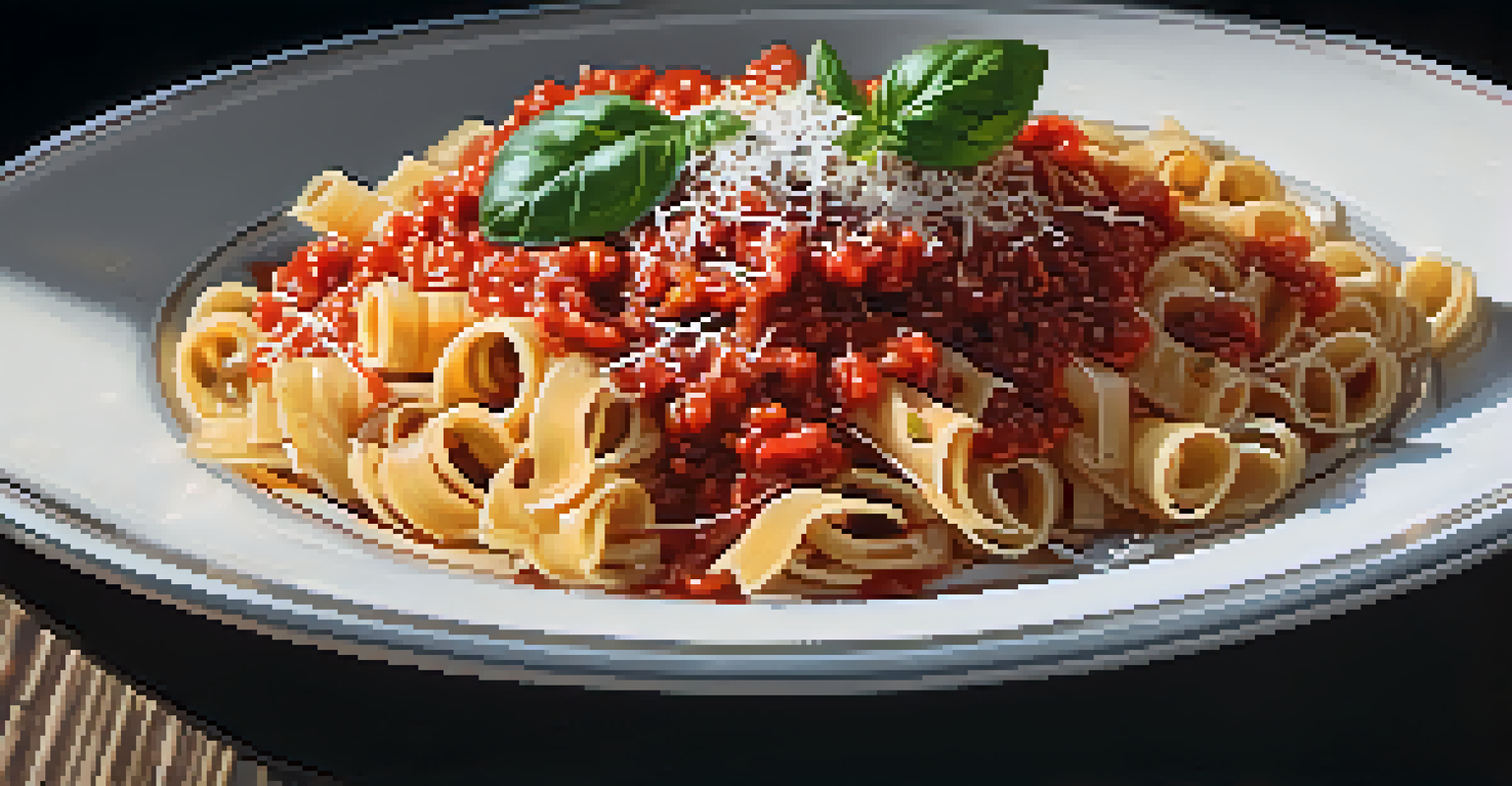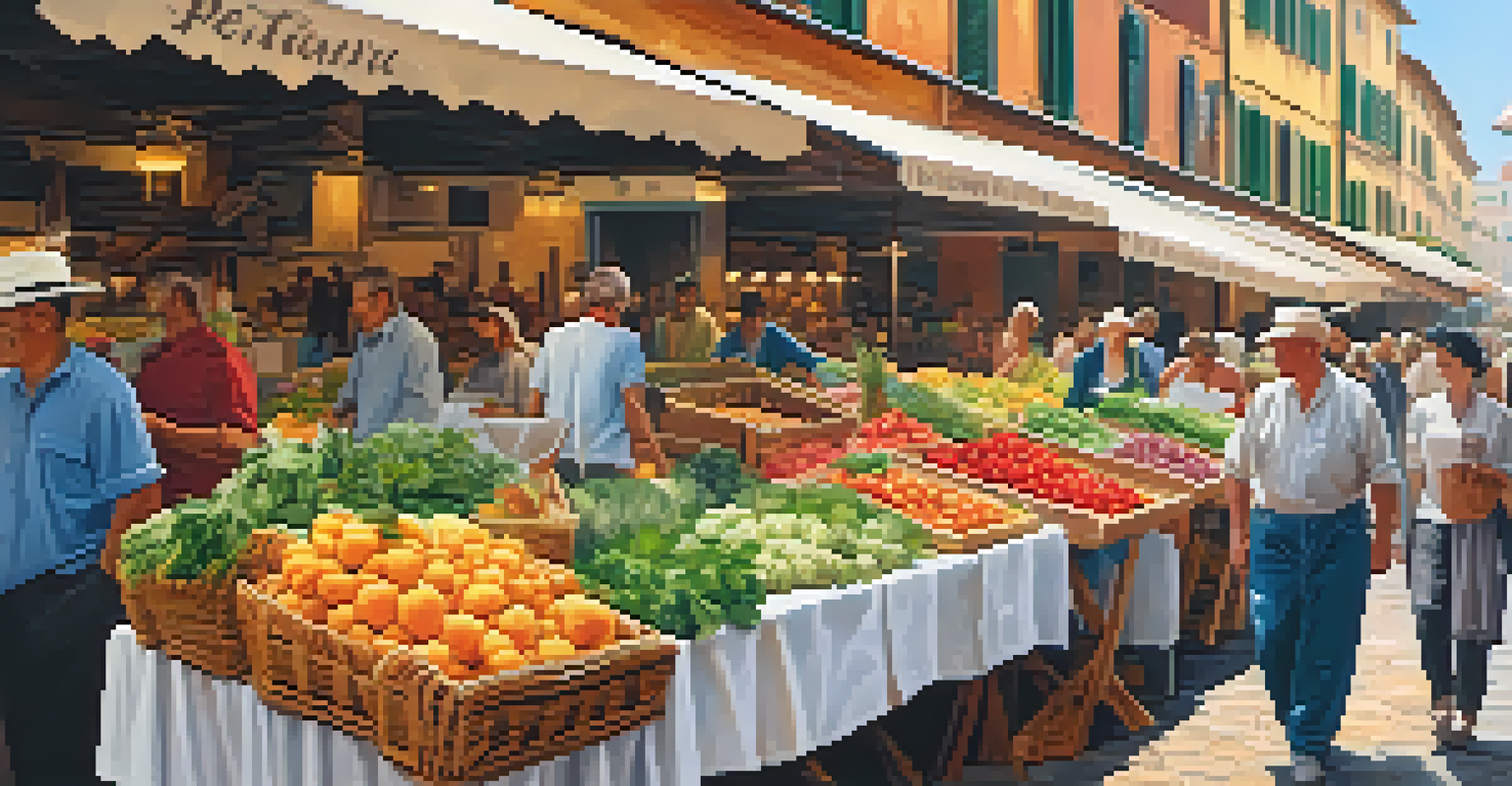The Evolution of Italian Cuisine: From Ancient to Modern

Ancient Roots: The Birth of Italian Cuisine
Italian cuisine has deep roots that trace back to ancient Rome and Greece. The Romans introduced a variety of ingredients such as olives, grains, and vegetables, laying the foundation for future culinary practices. They were known for their lavish feasts, which included exotic spices and meats, showcasing the importance of food in their culture.
Italian food is all about ingredients and it's all about love.
As trade routes expanded, ingredients from different regions began to merge, influencing local dishes. For example, the introduction of tomatoes from the Americas in the 16th century transformed Italian cooking, leading to the creation of iconic dishes like pizza and pasta. This blending of ingredients illustrates how Italian cuisine evolved through cultural exchanges.
Thus, the ancient era set the stage for a culinary tradition that would continue to develop, bringing together diverse flavors and cooking methods. Understanding these early influences helps us appreciate the complexity and depth of modern Italian cuisine.
The Influence of the Middle Ages on Italian Cooking
During the Middle Ages, Italian cuisine began to take on distinct regional characteristics. The feudal system promoted local produce and recipes, allowing different areas to develop their own culinary identities. For instance, Northern Italy became known for its use of rice and polenta, while Southern Italy focused on tomatoes and olive oil.

Food during this time was often tied to religion and seasonal festivals, with certain dishes prepared for specific occasions. This connection to culture and tradition ensured that food was not just sustenance but also a means of celebrating community and heritage. Cookbooks began to emerge, documenting recipes and cooking techniques for future generations.
Italian Cuisine's Rich History
Italian cuisine has evolved through ancient influences, regional diversity, and cultural exchanges that shape its beloved dishes today.
The Middle Ages thus contributed significantly to the regional diversity of Italian cuisine, setting the groundwork for the rich tapestry of flavors we see today. This period highlights the importance of locality and tradition in shaping culinary practices.
Renaissance Revelations: A Culinary Transformation
The Renaissance marked a period of significant change in Italian cuisine, driven by the revival of arts and sciences. This era saw an increased interest in gastronomy, with wealthy families commissioning elaborate banquets. Chefs began to experiment with flavors and presentation, elevating food to an art form.
Food brings us together, and it is a way to express our culture.
During this time, spices and herbs became more widely used, thanks to advancements in trade. The introduction of new ingredients like chocolate and sugar transformed desserts, leading to the creation of sweet dishes that are still enjoyed today. The Renaissance was a pivotal moment where food became a symbol of status and refinement.
This culinary evolution during the Renaissance paved the way for what we now consider classic Italian cuisine. The emphasis on aesthetics and flavor continues to influence chefs and home cooks alike, showcasing the enduring legacy of this vibrant period.
Regional Diversity: Italy's Culinary Landscape
Italy is renowned for its regional diversity, with each area boasting its own unique dishes and ingredients. From the creamy risottos of Lombardy to the seafood-rich cuisine of Sicily, this variety reflects the country's geographical and cultural differences. Each region showcases local produce, traditions, and cooking methods, making Italian cuisine incredibly rich and varied.
For example, in Tuscany, you'll find hearty bean dishes and rustic bread, while the Veneto region is famous for its risottos and polenta. This diversity not only highlights the importance of local ingredients but also the ways in which history, climate, and culture have shaped food practices across the country.
Pasta: A Culinary Icon
Pasta's evolution from its ancient origins to a global favorite showcases both culinary innovation and the adaptability of Italian cooking.
The regional approach to Italian cooking allows for a vast array of flavors and styles, making it an exciting cuisine to explore. It's a reminder that Italian food is not monolithic but a celebration of the myriad influences that have come together over centuries.
The Rise of Pasta: A Staple of Italian Cuisine
Pasta is perhaps the most iconic element of Italian cuisine, with a history that dates back to ancient times. Initially made from simple ingredients like wheat and water, pasta has evolved into countless shapes and forms, each with its own cultural significance. From spaghetti to ravioli, each variety serves as a canvas for a wide range of sauces and flavors.
The popularity of pasta surged in the 19th century, particularly with the unification of Italy, which helped standardize recipes and cooking techniques. Italian immigrants brought their love for pasta to other countries, further popularizing this staple around the globe. Today, pasta is synonymous with Italian cuisine and is enjoyed in various forms worldwide.
The evolution of pasta not only reflects culinary innovation but also the adaptability of Italian cuisine. It embodies the spirit of creativity and resourcefulness that defines Italian cooking, making it a beloved comfort food for many.
Modern Italian Cuisine: A Fusion of Tradition and Innovation
In recent years, modern Italian cuisine has embraced both tradition and innovation, creating a dynamic culinary landscape. Chefs are experimenting with new techniques and fusion styles while still honoring classic recipes. This blend of old and new is evident in contemporary dishes that maintain the essence of Italian cooking yet bring fresh perspectives to the table.
For instance, you may find traditional pasta dishes reimagined with unexpected ingredients or cooking methods, such as using molecular gastronomy to create unique textures and flavors. This willingness to innovate while respecting tradition reflects the evolving nature of Italian cuisine.
Future Trends in Italian Cooking
The future of Italian cuisine is focused on sustainability and plant-based adaptations, blending tradition with modern culinary trends.
Modern Italian cooking celebrates creativity and adaptability, allowing for a diverse range of interpretations. It shows that Italian cuisine is not static but a living, breathing entity that continues to evolve with each generation.
Italian Cuisine Goes Global: A Culinary Ambassador
Italian cuisine has transcended borders, becoming a beloved choice across the globe. From pizza and pasta to gelato and espresso, these dishes have become synonymous with comfort food in many cultures. This global popularity speaks to the universal appeal of Italian flavors and cooking techniques.
Restaurants featuring Italian cuisine can be found in nearly every corner of the world, showcasing regional specialties and adaptations to local tastes. This international presence has also led to the emergence of Italian-American cuisine, which combines traditional Italian recipes with American culinary influences, creating a unique fusion.

The global reach of Italian cuisine highlights its adaptability and the way it resonates with people from various backgrounds. It serves as a culinary ambassador, fostering connections and appreciation for Italian culture through food.
The Future of Italian Cuisine: Trends and Innovations
Looking ahead, Italian cuisine is poised to continue evolving with emerging trends and innovations. Sustainability is becoming a key focus, with chefs and home cooks alike prioritizing locally sourced, organic ingredients. This shift encourages a deeper connection to food and the environment, reflecting broader global movements toward sustainability.
Additionally, the rise of plant-based diets is influencing Italian cooking, leading to creative adaptations of traditional recipes. Chefs are exploring how to incorporate more vegetables, legumes, and alternative proteins into classic dishes, ensuring that Italian cuisine remains relevant in a changing culinary landscape.
As we embrace these trends, the future of Italian cuisine will likely blend tradition with modern sensibilities. This ongoing evolution ensures that Italian food will continue to delight and inspire future generations while staying true to its rich history.